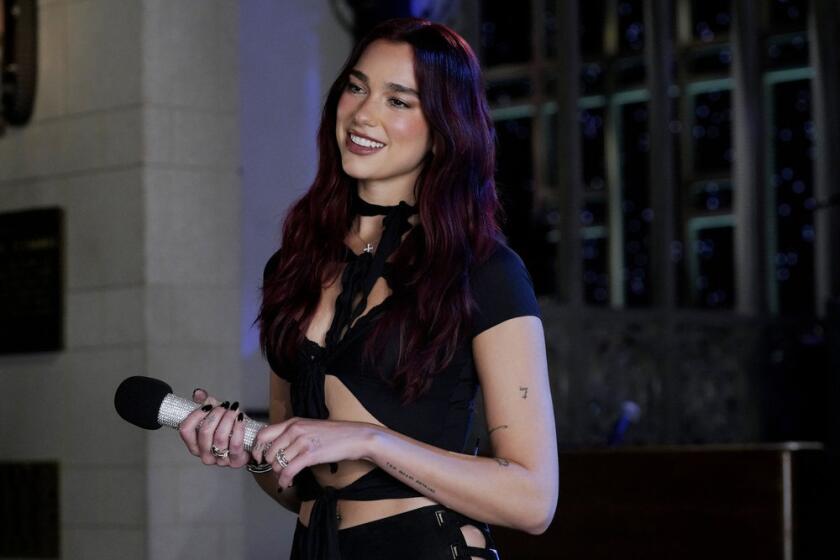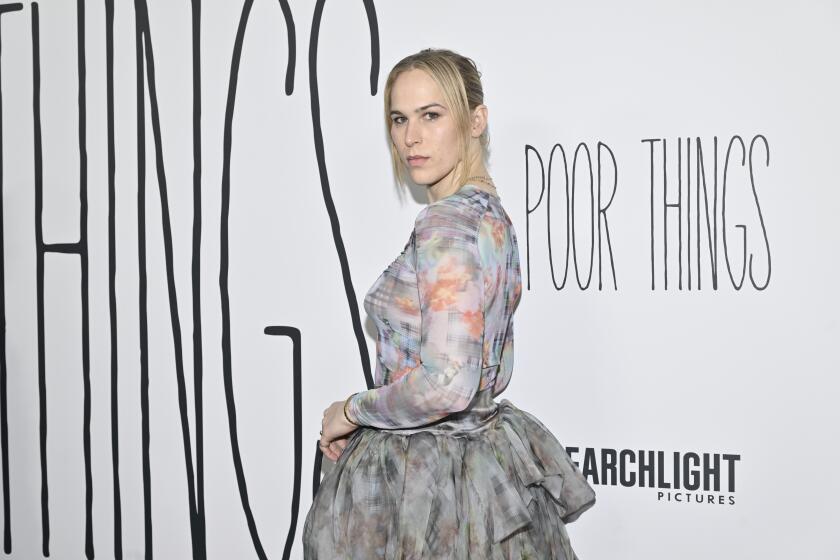They’re the Talk of Middle-Age Women : Careers: Public access television hosts say their friendship helps them explore contemporary issues with humor and honesty.
Best friends Susan O’Connor and Ailene Watson love to talk.
And now that their children are grown and out of the house, the two Manhattan Beach mothers are trying to make a career of their favorite pastime.
For the last year and a half, O’Connor, 47, and Watson, 55, have produced and hosted “It’s My Turn,” a cable show on public access television that explores issues concerning middle-age women.
Although the half-hour programs have dealt with such topics as low-fat cooking and fashion for women over 45, the two friends recently began tackling tougher issues such as menopause, careers, divorce and plastic surgery.
They had so much to say on the latter subject that they devoted three shows to it, the last one culminating in a bedside interview with O’Connor as she recovered from a face lift and chin implant.
“I think the message we’re sending out is (that) anything at this age is possible, that whatever you want to do with your life is OK,” Watson said. “If it means undergoing plastic surgery or joining a zydeco band, hey, go for it. It’s your turn now. We’re behind you.”
Although there are no viewer figures for the show, cable company officials say “It’s My Turn” is one of the most popular on their public access lineup.
“I know they get a lot of feedback,” said Patty King, production supervisor for MultiVision Cable, which has 20,000 subscribers in Manhattan Beach and Hermosa Beach. “I get people calling here all the time saying they saw the show and want to be on it.”
The show, which opens with a middle-age woman in a one-piece bathing suit jogging along the beach, is tempered with humor and emotional honesty. While interviewing a doctor for the plastic surgery series, for instance, O’Connor pressed a foam implant against her chest as if trying it on for size.
In a later show, the women filmed themselves during pre-surgery interviews with a psychologist at the plastic surgeon’s office. The interviews took place just a couple of days before they both went in for their face lifts.
“I’m terrified,” O’Connor revealed on camera. “It’s like a wave of anxiety just enveloping me.”
For some women, the plastic surgery series contradicts the show’s broader message--that middle-age women should accept themselves and feel good about entering this stage of their lives.
“I think it’s kind of a mixed message because I think you should feel good about who you are anyway, without having to change your appearance to make it more acceptable to someone else,” said Anne Dunn, a middle-age woman who works for the Los Angeles City Commission on the Status of Women.
*
O’Connor and Watson disagree.
“If you feel that having a little nip and a tuck or having your eyes done might make you feel a little more vital, do it,” O’Connor said. “But don’t feel guilty about it or feel you owe anyone an answer.”
Although the women have ambitions to break into the paid television market one day, they are painfully aware of the show’s current limitations. They are the first to admit they are not professional interviewers, and there are technical shortcomings.
“If you have professional lighting, you look great,” O’Connor said. “But if you don’t have professional lighting, you look like you have the face lift from hell.”
It helps, however, that neither woman is a stranger to the camera. O’Connor, a flight attendant, also has worked as a print model and commercial actress for the past eight years. Watson, a former Broadway actress, has appeared in numerous soap operas and commercials. She also has worked as a stand-in for Lynn Redgrave during the filming of her Weight Watcher commercials.
O’Connor says she decided to start the talk show during a cruise to the Caribbean in the spring of 1991, after her life underwent some dramatic personal changes. Her three children, now in their early 20s, had just left the nest, and suddenly she and her business executive husband were getting divorced. Although it was scary to find herself single and alone, O’Connor said the experience freed her to examine her life and focus on herself.
“It just came clear as a bell,” O’Connor said. “I knew I wanted my own TV show and I wanted Ailene to be my partner.”
Although Watson’s life was comparatively calm--she and her husband, illustrator O. J. Watson, are approaching their 35th anniversary--she was intrigued by the idea of starting a talk show that would address the concerns of middle-age women. She had given up her acting career years before in order to raise her three sons--now 27, 29 and 30. In recent years, she had begun to find work doing bit parts on soap operas. But she was interested in something that would provide more opportunities for self-expression.
In April, 1991, the two friends signed up for a four-week production class at MultiVision Cable--a requirement of anyone wanting to produce a show for the public access channel.
“When we first got here, it was very intimidating,” Watson said. “There was all this equipment. I can hardly program my VCR. I thought, ‘What are we here for?’ ”
But the class turned out to be easier than they anticipated and by the time they had finished, they were ready to line up guests for their first show--a free-ranging, three-segment production that included interviews with a national champion speed walker, a cosmetologist and a money manager.
*
Now, the women and their director, Jo-Ann Brennan, estimate they spend a full week on each installment of “It’s My Turn,” doing everything from research and pre-camera interviews to filming and, later, editing.
Most of their guests have been local notables, people such as former competitive bodybuilder June Schneider and South Bay chef and restaurant owner Ronald Guidone.
Brennan says the close friendship between O’Connor and Watson provides the show with much of its strength. The women relish ribbing each other about everything from their respective hot flashes to whether one or the other has lipstick on her teeth. Although they sometimes are criticized for interrupting each other and trying to end the other’s sentences, their easy rapport lends an authenticity to the show, Brennan said.
“What’s nice about this is it’s like cinema verite, “ Watson said. “What people are going to see is what’s happening to us, what the process is all about.”
Women’s advocates say they are not surprised by the show’s popularity.
“I think there is a need for a forum for women of that age group,” said June Dunbar, a member of the Los Angeles County Commission for Women. “A man in his 40s, 50s or 60s is usually in a power position by then. They get a lot of rewards on the job. But a woman doesn’t, even when she is working.”
And that is one reason O’Connor and Watson have become increasingly convinced that their message needs to be heard.
“No one wants to say ‘I’m 55,’ ” Watson said. “Everyone shaves off some years. They don’t want to say ‘I’m menopausal’ because that’s like saying ‘I’m used up or not needed.’ But what we’re trying to say is you do have energy. You have years left. Be a voice out there. Be proud of the fact that you can start another career now that your children have left the house.”
When asked whether they foresee a day when they will have said everything that can be said about being a middle-age woman, they laugh.
“Women never, never run out of things to talk about--you know that,” Brennan said. “It’s just a bottomless, bottomless pit.”
The complete guide to home viewing
Get Screen Gab for everything about the TV shows and streaming movies everyone’s talking about.
You may occasionally receive promotional content from the Los Angeles Times.



